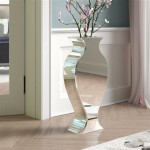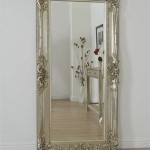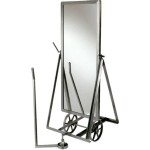DIY Paint Mirror Frame
A mirror, often a functional and decorative element in any room, can be further enhanced with a custom-painted frame. This allows for personalized style and integration with existing decor. A DIY approach offers creative control and cost-effectiveness compared to purchasing a new framed mirror. This article will guide readers through the process of painting a mirror frame, covering necessary materials, preparation steps, painting techniques, and finishing touches.
Materials Required: Several materials are necessary for this project. These include the mirror (with or without an existing frame), painter's tape, drop cloths or newspapers, sandpaper (fine and medium grit), a cleaning solution (such as mild dish soap and water), primer suitable for the frame material, paintbrushes appropriate for the chosen paint and frame design, paint in the desired color and finish, and a sealant (optional, depending on the paint and desired finish). Gathering these materials beforehand ensures a smooth and uninterrupted painting process.
Preparing the Mirror and Frame: Proper preparation is crucial for a successful paint job. First, protect the mirror surface from paint splatters by carefully applying painter's tape along the inner edge of the frame. Cover the surrounding area with drop cloths or newspapers to protect furniture and floors. If the frame has an existing finish, lightly sand it with medium-grit sandpaper to create a better surface for primer adhesion. For smoother frames or those with a glossy finish, sanding is particularly important. Clean the frame thoroughly with a cleaning solution to remove dust, dirt, and grease, and allow it to dry completely before proceeding.
Priming the Frame: Primer provides a base for the paint to adhere to, resulting in a more even and durable finish. Select a primer appropriate for the frame material, such as wood primer for wooden frames or metal primer for metal frames. Apply a thin, even coat of primer to the entire frame, ensuring complete coverage. Allow the primer to dry completely according to the manufacturer's instructions. If necessary, apply a second coat of primer for optimal coverage and adhesion, particularly on darker frames or when using lighter paint colors.
Painting the Frame: With the primed frame dry, the painting process can begin. Select paint appropriate for the frame material and environment (e.g., acrylic paint for indoor use, exterior paint for outdoor mirrors). Choose a paintbrush suitable for the chosen paint and frame design. A smaller brush offers more precision for intricate details, while a larger brush is suitable for broader surfaces. Apply thin, even coats of paint, allowing each coat to dry thoroughly before applying the next. Multiple thin coats generally provide a smoother and more durable finish than one thick coat. Avoid overloading the brush to prevent drips and ensure a clean, professional look.
Technique Considerations: Different painting techniques can achieve various effects. Brush strokes can be left visible for a textured appearance, or minimized through careful application and blending. For a distressed look, sandpaper can be used to lightly sand areas of the painted frame after it has dried, revealing the underlying primer or frame material. Masking tape can be used to create stripes or geometric patterns. Experimenting with different techniques on a sample piece before painting the actual frame can be beneficial.
Finishing and Sealing (Optional): Once the final coat of paint is dry, a sealant can be applied to protect the finish and increase its durability. Select a sealant compatible with the chosen paint. Apply a thin, even coat of sealant according to the manufacturer's instructions. Allow the sealant to dry completely before handling the mirror. The use of a sealant is particularly recommended for frames exposed to moisture or frequent handling.
Removing Painter's Tape: After the paint and sealant (if used) are completely dry, carefully remove the painter's tape. Pull the tape away from the mirror at a 45-degree angle to prevent lifting the paint. If any paint has seeped under the tape, a sharp utility knife can be used to carefully score the edge of the paint before removing the tape, ensuring a clean line.
Reinstalling the Mirror: Once the frame is completely dry and the painter's tape is removed, the mirror can be reinstalled in its designated location. Ensure the frame is securely attached to the wall or other supporting structure. Clean the mirror surface with glass cleaner to remove any dust or fingerprints accumulated during the painting process.
By following these steps, individuals can successfully transform a plain mirror into a personalized statement piece. This DIY approach offers a cost-effective and creative way to enhance home decor and express individual style.

Easy Chippy Painted Mirror Diy Hallstrom Home

How To Paint A Mirror Frame Gold Easily In Two Steps

Spray Painted Gold Yard Mirror How To Paint A Frame

Painting A Mirror Frame Easy Yet Stunning Ideas Diy Frames

How To Paint Gold Mirror Frame Keeping The Ornate Features Vickymyerscreations

How To Paint A Mirror Frame An Easy Diy Home Decor Project

How To Spray Paint A Mirror Frame Perfect Beginner Diy Project Design Morsels

How To Paint A Mirror Meg Del Design Furniture Diy Blog

How To Paint A Mirror Frame Give It Depth And Dimension Great Tips With Links The Exact S Used Painting Frames Diy Decor

12 Techniques To Painting Antique Mirrors Hallstrom Home








